Almost all the breads I bake are hearth loaves, but I've been tempted for some time to make one of the German-style ryes that Hamelman says should be baked in a pullman pan (AKA pain de mie pan).

Pullman or pain de mie pan
I purchased a pullman pan from KAF's Baker's Catalogue. It is from the new line of bakeware they are carrying, and it is a beautiful piece of metal. But this is not a review of baking pans, so back to bread …
Today, I baked the “70 Percent Rye with a Rye Soaker and Whole Wheat Flour” from Hamelman's Bread. It is made with medium rye, all pre-fermented. The rye soaker is in the form of rye chops – an equal weight to that of the medium rye. The remaining 30% of the flour weight consists of whole wheat flour. The dough is 78% hydration and has 2% salt and ¼ tsp of instant yeast.
Not having rye chops at hand, I hand-chopped the 390 g of rye berries needed for making 2 kg of dough, which is what is needed to fill my 13” pullman pan. (Did I tell you how beautiful it is?) Now, I believe that Andy (or was it MiniO?) claims the proper way to make rye chops by hand is to slice each berry into 3 equal pieces. I didn't do that. After trying to chop the berries on a cutting board with a chef's knife, which sent berries – whole and in fragments of varying sizes and shapes – flying everywhere, I turned to the chopping method I learned at my mother's knee. She never chopped rye berries, I'm sure, but she sure chopped a lot of fish for gefilte fish in the years before the coming of the Cuisinart. I still have her chopping bowl and hackmesser. (I believe that's what she called it.)
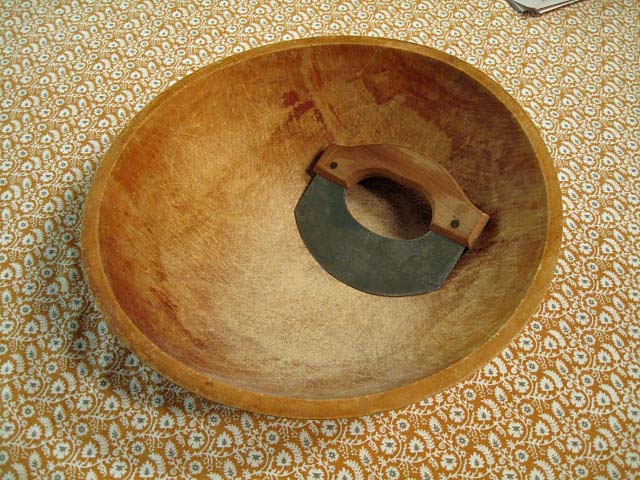
Well, I made a lot of little pieces of rye, but I figure I ended up with a mix of coarse rye flour, cracked rye, rye chops and whole (and very smug) rye berries. So, I poured boiling water over the whole mess and ordered a grain mill.
This morning my rye sour was ripe and smelling wonderfully sour and fruity. My soaker was soaked. I mixed the dough.
Now this is a 70% rye, since the cracked rye is included as a flour in calculating baker's percentages. But, really, if you look at the flour, it's about 50% rye and 50% whole wheat. I've made several other 70 and 80% ryes before, and this was different. There was much less gluten development with mixing. I've not yet made a 100% rye, but I imagine it's not much different from this dough. Maybe it was the whole wheat flour, whereas the other ryes I'd made used high-protein white flours. This dough was completely like sticky clay. But not insurmountable.
I mixed the dough in my KitchenAid – about 2 minutes at Speed 1 and 6 minutes at Speed 2. Then, the dough was fermented for 60 minutes. (Hamelman says ferment for 30 minutes, but my kitchen was only about 67ºF today.) I formed the dough into a log and placed it in the pullman pan which had been lightly oiled and dusted with pumpernickel flour. After 60 minutes proofing with only a little expansion of the dough, the loaf was baked with steam for 15 minutes at 480ºF, then for another 60 minutes in a dry oven at 415ºF. The last 15 minutes of the bake was with the loaf out of the pan, on a baking sheet, to dry the sides of the loaf. There was really nice oven spring. The loaf crested well above the top of the pan. (Sorry, I neglected to photograph the baked loaf still in the pan.) In hindsight, I probably should have proofed more fully. There was some bursting of the loaf on one side, at the point it expanded over the top of the pan.
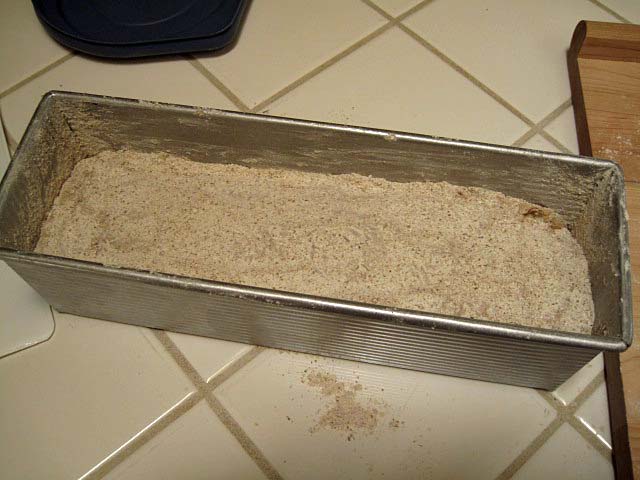
Rye dough in pan, sprinkled with pumpernickel flour and ready to proof
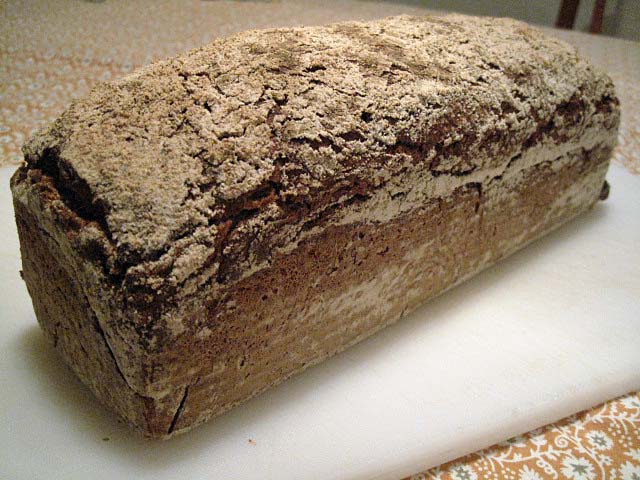
Rye bread cooling
After cooling, I wrapped the loaf in baker's linen, as instructed.

Rye wrapped in linen
The loaf was wrapped in baker's linen for 24 hours before slicing ... and tasting.

Pre-slicing (Big bread, isn't it?)
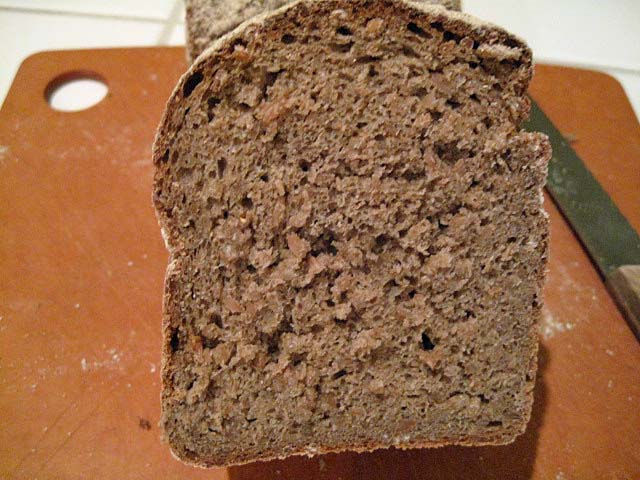
Coronal section with crumb
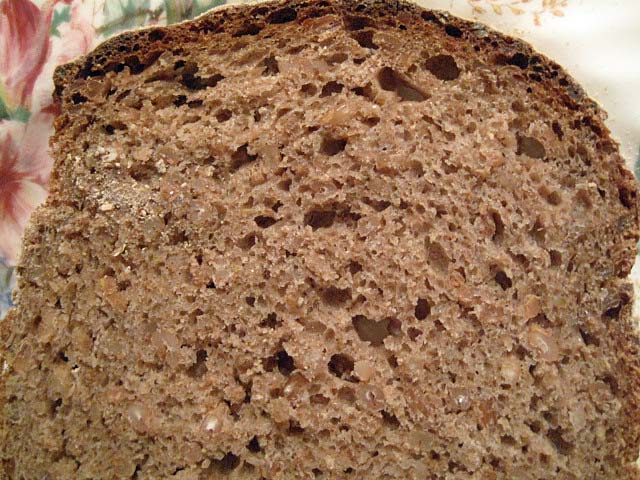
Crumb, close-up
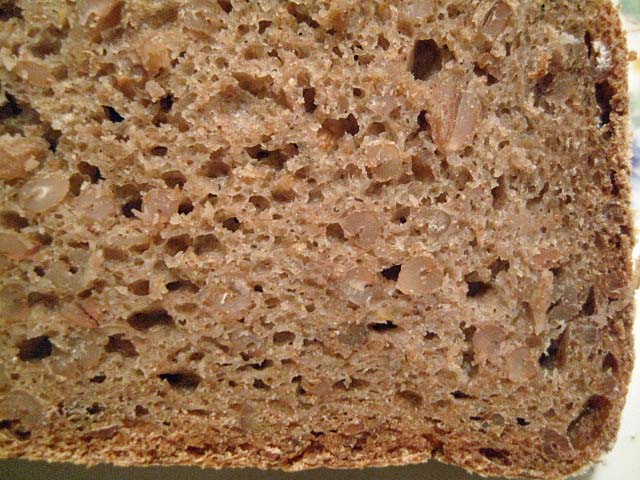
Another close-up
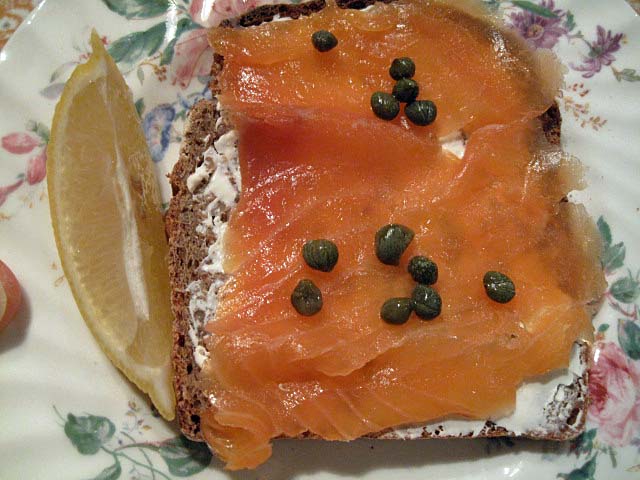
Delicious plain. More delicious with smoked salmon!
The crust was firm but not hard. The crumb was soft and moist but slightly crumbly and less dense than I expected. The aroma is powerful with rye, yet the flavor is relatively mild. It is rye with no distinctive whole wheat tones, yet the whole wheat must have mellowed the rye flavor. There is a sweet note to the aftertaste. The rye "chops" are very chewy, which I like.
This bread has lots of character, and I enjoyed it unadorned. I had another slice with a thin schmear of cream cheese and a thin slice of Scottish smoked salmon, with some capers and drops of lemon juice. Fantastic!
David
- dmsnyder's Blog
- Log in or register to post comments
I must gather some nerve and do one like yours. Very nice, David.. beautiful Rye!!
I don't think I have the nerve to cut berries into thirds. I might throw them into a bladed food processor. Pulse them just a little. Nice bowl and blade, it glows with good karma.
I might slip the loaf into plastic when completely cool, to balance the moisture better if the house is heated and trapping the aroma that begs to be tasted. Will power! It will cut so much nicer if you wait. You do want the perfect slice, right? (Dangerous question.)
I ordered the KitchenAid grain mill attachment which, supposedly, can grind "chops." I've been tempted to get a mill anyway by the claims of superior flavor from freshly milled whole grains.
The bowl and chopper evoke many fond memories, especially since they were most used to prepare holiday meals by my mother and grandmother. They must be at least 60 years old.
Hamelman recommends keeping rye breads wrapped in linen. My house is heated, but the humidity is not terribly low - in the 60-70% range this time of year.
I think I can hold off slicing the rye until dinner time tonight. I may have to leave the house until then though.
David
Very nice as always David. I can associate with the terribly daunting task of chopping berries by hand. I too have actually attempted to do it with my chef knife for a Hamelman recipe.
I just wish my local Co-op would hear my plea to sell rye chops, then again I might be the only buyer.
Get the salmon ready for when it comes time to slice that loaf!
Four oz of Scottish smoked salmon standing by!
David
Your bread looks fabulous and an adventure in the making. -Varda
Hi David,
When I read on Andy's recent post that you were going to chop rye berries with a chef's knife I said a silent "good luck" to you, remembering my own futile attempt at it. Tough little grains aren't they?
This a really good looking loaf of rye you've made here! Great rise and overall colour to it along with a generally uniform shape, which can be tricky to get with a rye paste.
Nicely done! Looking forward to seeing the crumb shots, but by all means take your time before slicing it. You won't regret it.
Franko
If you can source it in your area, cracked rye makes a good substitute for rye chops. It has a slightly different texture but that isn't really discernible after soaking and then baking in the bread.
That's a lovely loaf of bread, David. Did you bake it without the lid in place? Or did the doming occur after you removed the lid part way through the bake?
Paul
I've seen neither rye chops nor cracked rye locally. We'll see what kind of texture my hand-chopped rye lends the loaf.
Hamelman calls for this bread to be baked without the cover, and that's what I did.
David.
and then chop them? Drained, they might just lay there like nuts. Overnight, I soaked kamut berries to put into my rye today. I didn't think of chopping them though. I just threw them into the dough as is. But they are much softer than the dry.
Can you get rolled rye? They might be a good sub for chops.
Mini
I'm not sure I've ever spent two minutes with you anywhere when you haven't cracked wry.
Glenn
Hi David,
This is the description Shipton Mill in Gloucs give for their Organic Rye Chops, which are available to us in the UK by mail order. "The whole rye grain crushed into 2 or 3 pieces and used traditionally in the preparation of pumpernickel bread"
I note you used the yeast as included in Hamelman's formula. I suspect a slightly slow fermentation was due to your dough being slightly tight, as well as cooler than that specified in the recipe. I am basing this on the photo of the paste in the pan. Rye flour will absorb water in a sometimes infuriatingly variable way. Also, you used a hot soaker, where the recipe calls for cold.
Nico and I tend to agree on 85% as a target hydration for these types of bread. I've noted Giovanni has gone up to near 100%, hydration [see here: http://www.thefreshloaf.com/node/18458/segale ], and Andrew Whitley in "Breadmatters" also works on 100%. There are a number of dangers of water at this level, as you can imagine, not least, being able to bake out the loaf in the first place. Daisy_A has used Andrew Whitley's formula, but I think both his sour and final doughs are too wet for me to feel comfortable working with them. Hamelman seems happy just under 80%, I go just over. But the key point is that rye is far more variable even than wheat in its ability to absorb water.
Lovely colour to the finished bread, and I'm keen to see the crumb, and how your improvised "chops" have contributed to the texture.
Lovely looking bread, and I agree about the Pullman Pan too.
Best wishes
Andy
Do you think the "target hydration" for a high-percentage rye would be the same or different depending on whether it is baked as a hearth loaf or in a pan?
If you were to take a formula, like this one at 78% hydration, and increase the hydration to 85%, would you alter your baking time or temperature?
I need to check on what you mean by the "dough being slightly tight?" Do you mean "dry?" I'd say, for a high-rye dough, it was on the "medium" side. It was not really dry, but it held its shape when formed into a loaf.
The new bakeware from KAF is heavy-duty. It uses corrugated metal which they say improves even browning. I can say, the sides of the loaf were very firm, even with another 15 minutes left in the bake. I was amazed at how easily the bread released from the pan. It slid right out by gravity. Nice hardware.
David
Hi David,
I did respond to Khalid [mebake] recently about baking these as hearth loaves. Not that I actually have any experience of making these myself. Yes, I think I would make them slightly firmer were I to try it.
I've played around with a number of methods of baking these high rye loaves. We used to bake them at the back of our large wood fired oven at Village Bakery, for about 45 minutes [950g scaled weight of paste] Rack ovens we baked at 210*C for 50 mins to 1 hour. At home, the most successful bake was on the last post; see here: http://www.thefreshloaf.com/node/21307/some-variations-hamelman039s-quot80-sourdough-rye-ryeflour-soakerquot However, I really like to use steam for these breads, especially the HB Black Pumpernickel in Hamelman's book. For this I use the combi oven in College and steam for 12 hours at 99*C. But, yes, your question is pertinent and baking out the extra water takes extra time: apply that to the 100% hydration in Whitley's formula! Also, remember that my recent post contained molasses, which necessitates further control of baking temperature to avoid over colouring.
Re "tight", I'd say you've got a good handle on what I'm talking about. Think about the term "clay" which Hamelman uses. It is in theory in direct relation to the amount of water in the formula. It really can be difficult though David. We had some appalling batches of Dark Rye Flour where we just had to add huge amounts of water to get the paste to settle as workable. By this point hydration was over 100% and we knew we had big problems...really big problems [we made 300 of these loaves at a time, and each one retailled for nearly £2 then [late 1990s!] The batches were rejected and we had to alter our methods and work with paste which was rock-like! The only solution we came up with was to slow down the rate of fermentation in the sour cultures by using cooler water. But the final loaves were poor compared to our normal efforts. Your version of "medium" would be what I consider to be tight. It does not need to be able to hold its own shape in the tin. However, you need to be able to use wet hands to "pan" the loaf in the first place.
Our Pullman Pans in the UK come from Bakery Bits http://bakerybits.co.uk/Professional-Pullman-Bread-Pan-P760043.aspx They seem to be a little different from KAF, but I suspect overall quality to be similar.
Very best wishes
Andy
I do need more experience with high-% ryes and the pullman pan.
The dough never came together in a ball in the (KA) mixer but firmed up with fermentation as the WW flour absorbed water. I take your point about the ability of whole rye flours to suck up water. I just need more experience, I think, to judge the consistency of high rye doughs.
I note that the pullman pan to which you provided a link is from Chicago Metallic. I use their heavy-duty, non-stick sheet pans and love them for baking everything from meatballs to bagels.
I'm building up the nerve to bake the HB Pumpernickel.
Well, it's about time to slice my rye!
David
...and a lot of effort in creating rye chops. They're a lot easier to come by commercially. You might try contacting a local bakery that makes good ryes to see if they'd be willing to sell you small amounts of chops and cracked rye.
I've had similar cracking problems with high percentage/hyrdation ryes that I allow to rise above the sides of the pan, and I think the problem may be less underproofing and more the need to fit less dough in the pan (Andy's suggestion to me as I recall).
In any event, look forward to seeing the crumb and getting your take on its flavor.
Larry
Comments would be welcome.
David
Looking good David. The crumb is nice and even and appears soft. I do notice that it may have needed longer to rest before cutting, which I know is difficult to do. I ran into the same thing when I did the HB and had a similar semi moist area around the edge as I'm seeing on right side of your loaf. This will go away over the next day or two, but I know when I do another hi-ratio in the Pullman pan I'll leave it for 24hrs+ before slicing.
Scottish salmon when you live so near the Pacific Coast??? To each his own I suppose.
I don't think you should have any major concerns about doing the HB considering the way this loaf has turned out. One suggestion regarding molding a rye paste I could pass along is if you have a plastic dough scraper, use it to press the paste evenly into the corners of the pan. Wet the scraper and lay it flat on the paste with the square corner lined up with the pan corner. Work the paste under the scraper right into the corner of the pan so that your loaf edges will be even and square when it's unmolded.
The other point I could suggest when you make the HB is to mix at least the final stage by hand. Because there's so little gluten from wheat present in the mix, it helps if you can get some 'hands on' tactile feedback to guide you in determining development as well as hydration of the paste.
Franko
David
Very Nice, David! Truly great crumb! I love these pans... BTW you could cook the Rye berries, as you would rice, only to the point where they are tender to the cut. and then easily chop them. My thoughts..
Great idea - cooking the rye berries! I wonder how you adjust the water for the soaker ... or if you still soak them if they are already cooked.
David
No, Don't soak them, they hold enough water cooked.
Well the addition of salmon hit the spot for me.
Thanks David.
Hi David,
Khalid is completely correct about cooking the whole berries. But you originally did not plan to use whole berries, just chops, if I'm not right? Ordinarily, the rye chops would not be cooked.
Regarding water absorption, you ask the most pertinent question concerning the cooking of the berries. Hamelman does not answer this in his extensive piece on HB Black Pumpernickel. Additionally, no clue is given as to how much water the "altus" will take up. I think it would be a hard call for him to achieve this in a reliable enough way to pass it on in the printed word. So, to an extent, you do have to "suck it and see". However, I did do the experimentation, and posted on it here: http://www.thefreshloaf.com/node/17254/horst-bandel039s-balck-pumpernickel
It's not gospel, but you can reasonably expect each cooked grain to just slightly double in weight when cooked. I think reliable water absorption with "altus" is rather more difficult to quantify, as it depends on what type of bread, how dry it is in the first place, and how long it is soaked for. Also, how much residual moisture is then squeezed out at the end of the soaking. But 1.5 times its own weight might be a reasonable guess.
Other than this, Hamelman's HB is a complete recipe and wonderful story, which has rightly attracted a lot of fans at TFL. Hope you enjoy making it. Personally, I think the most difficult steps are in the baking. There is plenty of detail to prepare and ferment the paste in the first place. Baking 2kg of paste containing molasses and water @ 85% on "flour" [actually flour, chopped grain and whole grain] is not easy to get right. As Hamelman explains, these loaves were baked on the dead oven once the day's other baking schedule was complete.
I think your crumb looks really good, with berries and wholewheat clearly evident. The crumbliness does suggest you may be able to get higher hydration, but still really good looking bread.
Best wishes
Andy
I think the only way I'm going to get the hydration right is experience. I think I can judge this well with wheat flour doughs, but rye is a different thing entirely.
I also think Franko's suggestions about packing the dough in the pan are to the point. One side of the bread tends to crumble off during slicing, suggesting a problem with "forming" the loaf.
In any case, I had some more of this bread with salmon for breakfast, and it's even better today with somewhat more of a sour tang.
David
about a cupped handful (yeah, I know!) to soak up extra water and stiffen the dough a little for a free form 85% hydration, it might even be a little bit more. When handling with wet hands, I don't stick but the added water seems to not affect the dough. I like it. I get a shape that holds itself well. I'm hoping it will give off the moisture in the bake and give me a nice standing shape. So far it is working with the handling. I'll know more when I get to the final shape before baking. My altus is a dark walnut rye. Roasted sesame seeds and soaked roasted pumpkin seeds in there too. This loaf gets baked in my ufo (two black alu woks rim to rim).
David, the crumb shots look great and moisture looks right. The top is nicely browned, more so than the bottom. Wonder if it would be worth the trouble to foil tent the top when it's brown enough and let the bottom catch up.
Mini
David--
It gives me a glow of pleasure to see the old hackmesser. I wonder how many pounds (tons?) of Pike and Lake Erie Whitefish have been chopped into gefilte fish with that antique. Great memories.
I'm pretty sure it had never been used for chopping rye berries.
As to the rye bread, it is beautiful. Especially covered with smoked Salmon.
Glenn
...about the new line of pans from KAF & if I'd ever use a Pullman loaf pan. I just ordered Hamelman's book so I'll probably need one eventually. I might have better luck with an 8# sledge on raw berries because chopping with a blade like that is pretty scary!
Beautiful loaf, David (and the Salmon looks good, too).
Toni
In hindsight, I should have tried chopping the rye berries in the blender. A sledge would probably mash them pretty well, unless your notion was to use the hammer with a chisel.
The USA Pan bakeware is exclusive to KAF, when it has "KAF" stamped on the bottom. However, many pieces from their line are carried by Bed, Bath and Beyond.
Have a happy New Year!
David
Nice bread David. I saw the bread a couple of days ago, and began putting together a hasty post, but I became summoned for errands. Lovely bread, and the pictures say it all. I read somewhere that chia seeds can begin to gelatinize before the bake. Is this what is at work re. Mini's post? The salmon looks awesome. Thanks, and Happy New Year. Ray
but I do think it has a bit too large holes for a rye bread of that type.
Happy New Year
Karin
Any suggestions for how to remedy this?
David
and your description, I have these thoughts about it:
1. This dough will be like clay and not have a strong gluten development. I regularly bake the Vollkornbrot from WGB, which has a a little bit of gluten development and my Rheinländer Schwarzbrot - Rhineland Rye (with cooked rye berries, rye flour and whole wheat flour) that has hardly any.
2. I don't think you can consider this bread really as being in principle 50% rye and 50% wheat - the cracked or chopped rye is a kind of "dead weight" that the wheat gluten has to lift, too.
3. You mention a "nice oven spring" - I'm not so sure that a bread of this kind should have a considerable oven spring.
But before I go into a lot of speculations about it, I should probably rather try baking it myself. The 4 kinds of German higher % rye breads I make all behave somewhat different. But whereas Bauernbrot (Farmer's loaf) type rye meteils have a great oven spring, all those darker rye have much less of it.
My next project which I'll start tomorrow with be Hamelman's "5-Grain Sourdough with Rye Sordough"
Karin
Hi there,
Thanks for the very informatice posts.
I am facing an interesting problem and could not come with a solution.
We do not have cracked or chopped rye in Israel.
My question is if there's a way to use the original grain for the soaker.
Thanks a lot,
David Zonsheine
Hi, David.
You can use whole rye berries rather than chops or cracked rye, but the whole berries should be cooked by boiling them for an hour then draining them. This is used in some of Hamelman's formulas.
However, if you have a food processor, blade coffee grinder or grain mill attachment to a stand mixer, you can use one to produce rye chops.
One of the more experienced German-style rye bakers like Mini Oven, Ananda or Karin may be able to give you more experience-based advice than I.
David
I don't think you can grind rye berries in a food processor or coffee mill. I tried it with both, but rye is too hard, you get a little bit dust and the berries remain nearly unscratched.
I would rinse the rye berries, soak them for 24 hours in cold water, drain, and rinse them again, then cook them for 1/2 an hour, as I do for my Schwarzbrot.
Karin
Sorry to hear the food processor/coffee mill doesn't work.
Glenn picked up some rye chops at CM last week. I'm looking forward to baking with the real thing.
Daivd
Thanks a lot David
How much time before mixing should I mix the boiling water / soaker?
Hi, David.
Sorry, I missed your message until today.
I generally mix the soaker the night before mixing the final dough.
David
I should boil the rye berries for 1 hour then cool them and and to the the mixing or do I still need the night before?
Thanks a lot (I've already tried with boiling the berries and got terrific result for a first time)
I've made rye breads with a hot soaker and others with soaked then boiled berries. With the latter, as I recall, the berries were soaked overnight then boiled and cooled the day of the bake.
David